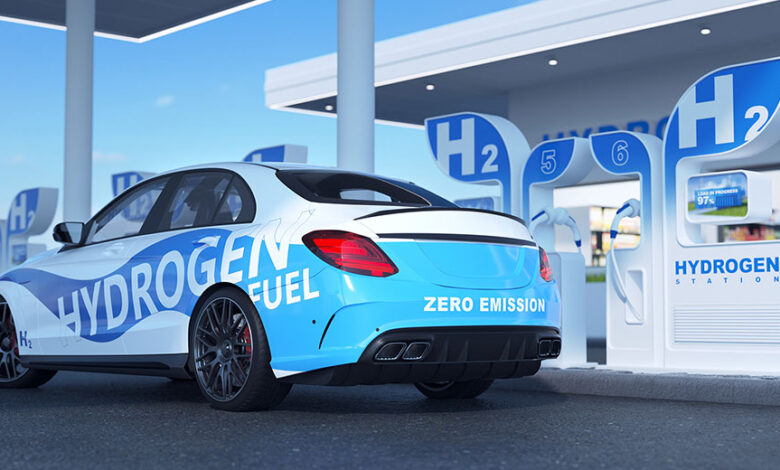Can Hydrogen-Powered Cars Leave EVs in the Rearview?

The collaboration between Honda and GM to develop hydrogen cars, Toyota’s ongoing support for hydrogen technology, and the potential for retrofitting traditional gas engines to run on hydrogen might lead some to question the future viability of electric vehicles.
Despite the availability of conversion kits in Europe that transform gas-powered cars to hydrogen, drivers have limited their adoption due to reliability issues. These modifications have often resulted in less dependable vehicles, contrasting sharply with the more reliable performance of electric cars equipped with hydrogen fuel cells.
Now, Toyota has developed a unique hydrogen engine that will run more reliably on hydrogen than a converted gas engine, but it will lack the performance advantages of the more common fuel cell approach. Both types of power have one huge problem: there is no hydrogen infrastructure, and hydrogen generators aren’t cheap.
Let’s talk about hydrogen-powered cars this week. Then, we’ll close with my Product of the Week — a car out of Switzerland called the Microlino. It could be the perfect electric for situations when electric cars work best: short hops.
Hydrogen vs. Electric Cars
On paper, hydrogen is the better choice to power a car than a battery. This superiority stems from the fact that, in most implementations, you get the attributes of an electric vehicle, which is an exceptionally reliable motor, and you don’t get the worst part, which is the battery.
Much like gas tanks don’t wear out — although older ones did rust out if you didn’t take care of them — hydrogen tanks would be no different because they last indefinitely if maintained properly.
In both cases, fuel delivery systems need to be maintained, and since hydrogen typically is supplied in liquid form, it is under pressure, which adds to the cost and complexity vs. gas; it is still potentially far more dependable than batteries are today.
Toyota’s approach of using a special internal combustion engine (ICE) is interesting because you get the ICE experience (engine sound, etc.), but you get the complexity of that engine type, as well.
Internal combustion engines tend to be far less dependable than electric motors because they are more complex. But, if you are used to a gas car, this experience should be quite similar. So, the Toyota approach could be the best bet for someone who wants that gas car roar and feel.
To get a similar experience from an electric motor, you typically have to add engine sounds artificially, a solution that, to date, hasn’t been exceedingly popular. Both BMW and the first Fisker did this with mixed results. Electric car owners typically get over the need for sound quickly, particularly when they experience the benefits of massive torque and acceleration from an electric car.
So, if you are talking about where most automakers are taking hydrogen, like into fuel cell cars, on paper, the hydrogen-powered vehicle is far superior to the electric battery vehicle.
But Hydrogen Has a Huge Problem
What made Tesla work is the massive investment the company made in an electric ecosystem combined with the rapid introduction of low-cost Level 2 chargers that allowed you to charge up at home.
You can get Level 2 electric chargers for under $300 and a good flex charger like the one I use, the ChargePoint Home Flex Charger for under $600.
With the expansion of public chargers, the United States saw over 53,000 charging locations by 2022, as reported by Statista. This expansion indicates that despite issues with the reliability of public chargers, their availability is substantial, and they are being installed at an increasing rate. California alone has over 44,000 of these charging stations.
In comparison, there are currently 111,000 gas stations across the U.S., so we are about 50% of the way to parity if you don’t consider many of these stations are often out of service.
Compare that to only 58 public hydrogen refueling stations in the U.S., with 57 of those in California. So good luck getting fueled in any other state in the U.S.
Projections suggest there will be as many as 4,300 hydrogen fuel stations in the U.S. by 2030, but most of these are for commercial use. That’s still a tiny fraction of what we have with electric charging stations today, and there aren’t enough public charging stations.
So, with nearly 1,000 times the number of projected charging locations, electric battery-powered cars are approaching the same advantage that gas cars now have when it comes to fueling locations — or they would if these charging stations were more dependable.
Still, the number is far higher than hydrogen. I should add that current forecasts have us at 35 million electric car chargers by 2030. Granted, most will be in homes, but that’s still a massive number.
Home Hydrogen Fueling and Infrastructure Hurdles
But what about home hydrogen fuel? Well, that’s going to be a problem.
A home hydrogen generator not only needs electricity to power it, but it needs water, as well, making it harder to install, and it costs around $12,000. So, while you can fuel up at home much like you can charge an electric car, the cost of the fueling system is prohibitively expensive.
The cost of the hydrogen generator itself isn’t the only problem. Fully charging an electric car is around $10, while fueling a hydrogen car is closer to $75. Driving approximately 60 miles would cost around $4 for an electric and closer to $15 for a hydrogen car.
Currently, hydrogen has a similar problem with fueling that electric cars have with charging, but it is far worse in terms of ecosystem availability and fuel cost. The only way around this is to build a massive, low-cost hydrogen fueling infrastructure like Tesla did for EVs, but no one seems to be doing that for anything but commercial hydrogen vehicles.
This situation is why GM and Honda are focusing their efforts in that direction. Toyota is nuts because it seems unlikely it’ll be able to fund the fueling infrastructure it needs outside of Japan. Toyota could make this work in Japan, though in 2022, there were only 250 stations there.
Wrapping Up
It costs around $1.9 million to build a hydrogen fueling station. Even if you could reduce that cost by $800,000 — by converting an existing gas station instead of building from scratch — to approach where electric charging stations are today, you would need 53,000 of them. That cost comes to over $58 trillion for the U.S. alone, and Toyota is only valued at around $273 billion, meaning it’ll need a ton of government help to build out the ecosystem.
By the way, this contrasts the $7.5 billion estimate to build out the EV charging ecosystem in the U.S. with 500,000 additional chargers.
Battery technology, which languished for much of the last century, is advancing quickly now. The Chinese electric car company Zeekr advertises over 640 miles of range (the electric cars from China are setting range records) for a car costing under $40,000, which is within striking distance of the Toyota Mirai hydrogen-powered car with an impressive 845 tested range.
I get that you can make commercial hydrogen vehicles work with the combination of superior range and depot fueling stations and a limited number of long-haul fuel stops. But consumer vehicles? Nope. The math just doesn’t work, so Toyota’s impressive effort will likely fail.
Given how far we’ve come with battery electrics, it’s just too late to switch to hydrogen because the cost of the switch is beyond what even governments are willing to pay to get it done.
Microlino Electric Car
When it comes to cars for local driving, you really can’t beat an electric. You can charge it at home, you don’t care about public charging, and you don’t need a ton of size or cost.
My new favorite in this class is the Microlino electric car out of Switzerland.
Sadly, there are no plans yet to sell this in the U.S., but that doesn’t mean we can’t wish for this awesome, little, and very affordable $14,000 car in the U.S.
Like the old BMW Isetta (my dad had two of those when I was growing up), the Microlino has several impressive advantages. It has an exceptional range of 60 to 143 miles for local travel, depending on the battery size selected. The front door (you open the front of the car to get in) allows you to park in very tight spots and still easily get in and out of the vehicle.
With a top speed of 55 mph (on a flat road), it will handle most local speed limits, though I’d stay off freeways. I tried an electric scooter that had a 56-mph speed limit a few years back and found the number of cars that seemed to want to run over me on a freeway disconcerting.
Still, if you want something for your kid to drive to school that’s safer than a bike, scooter, or motorcycle, or want a small second car for when your larger vehicle was in use by another family member but don’t want to tie up a lot of cash, this car could be an ideal option and, given how unique it is, it is likely to draw interest at your local Cars and Coffee.
The Microlino uses a Level 1 charger, which plugs into a regular AC plug and still charges the car in around four hours. So, the electricity cost would be negligible and in line with a typical large appliance.
I wanted this car as soon as I saw it, and sometimes I pick my Product of the Week based on how much I want the darn thing. Particularly, as is the case this time, when I’m not allowed to buy it. As a result, the Microlino is my Product of the Week.
I hope Amazon figures out how to sell these because I’d like to buy one.
Get Best News and Web Services here







